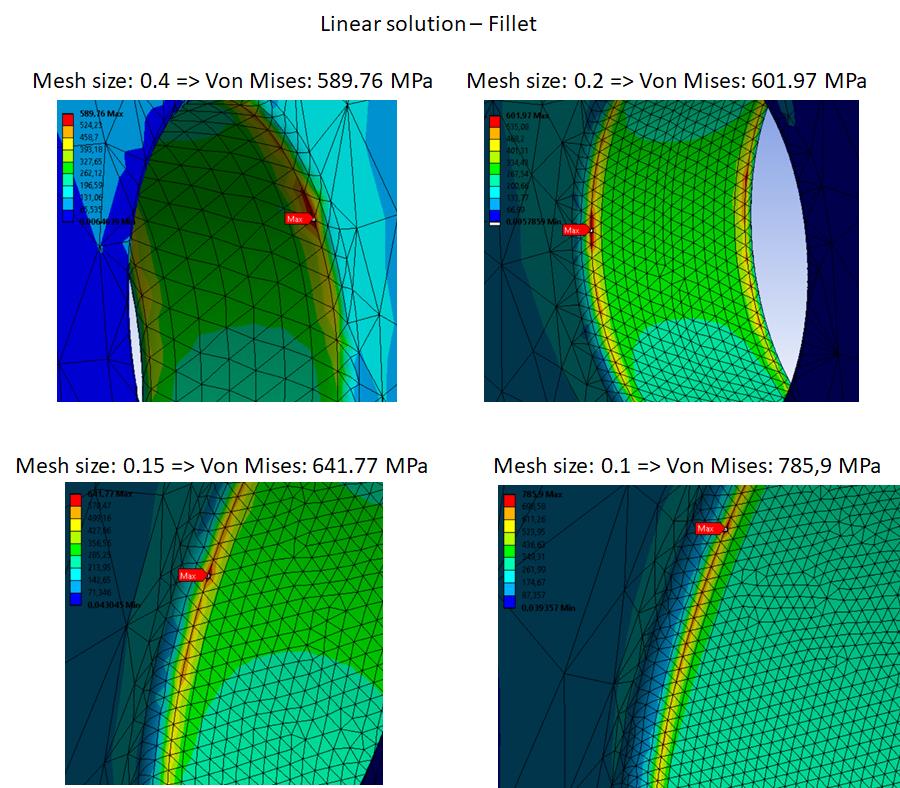-
-
July 8, 2020 at 2:09 pm
Fernando97
SubscriberHi everyone,
I'm facing a singularity issue in the edge of a fixed support condition, which is also a body edge, that's making impossible to do a mesh convergence analysis to the equivalent stress of Von Mises. In order to avoid this problem and to get a convergence curve, I adopted the non-linear method, which I defined the yield strenght value and the tangent modulus.
The simulated body is at an elevated temperature (about 350°C), and that makes the material (steel) ultimate strenght very close to the yield strenght value (about 5% higher than yield strenght), so I defined the tangent modulus as zero.
The problem is that even with the tangent modulus setted as zero, the equivalent stress converges to a value higher than yield strenght, and a little higher than ultimate strenght of the hot steel, while the plastic deformation is lower than 2%.
My doubts are:
1. Why does the equivalent stress converge to a value higher than yield strengh if the tangent modulus is setted to zero?
2. What should I do to resolve this issue? I've already tried to make a fillet on the edge, but that hasn't avoided the singularity, it's just moved to the boundary of the created fillet.
Thanks in advance
-
July 8, 2020 at 4:50 pm
peteroznewman
SubscriberReview the discussion on ERESX,NO to answer question 1.
How do you know the stress in the fillet is a singularity? Fillets generally take care of singularities. If you use a bigger fillet, the exact maximum stress will be lower. Use the Insert Image button to show your mesh on the fillet.
-
July 9, 2020 at 4:52 am
Fernando97
SubscriberHi Peter!
I`m sending pictures of what happens when I try to do a mesh convergence study using linear solution method.
Note: The first case is without fillet, I used the software tool to do the convergence study. The second case presents the hole with fillets and it was done 4 simulations refining the element size. In both cases (with and without fillets) the equivalent stress just increased as the element size decreased, that's why I think I'm dealing with singularities.
Regarding ERESX,NO command, I think it can help me, using it, the equivalent stress converged to a value very close to the yield strenght and I could see a plastic strain below 1%. Since the equivalent stress will not overcome the yield strenght, can I use this plastic strain to help me to determine if the body is submitted to an acceptable level of strain for its application?
Thank you!
-
July 9, 2020 at 10:07 pm
peteroznewman
SubscriberThe geometry above has an exterior sharp corner. Those don't tend to be stress singularities. It is interior sharp corners that are. A fillet adds material to an interior corner to allow stress to go around the sharp interior corner. You have taken a sharp exterior corner and added a round, which removed material from a sharp exterior corner.
You don't have a singularity, you just haven't made the elements small enough around the max stress location. Look at how small the automatic mesh convergence study made the elements. They are less than 1/4 of the size of your smallest 0.1 size. You would have to go to 0.025 to match that. If you get two more results at 0.05 and 0.025, you might find the plot of stress can be extrapolated to zero element size without the stress shooting off to infinity.
-
July 10, 2020 at 3:32 pm
Fernando97
SubscriberOk, Peter! Thank you!
Just one last question regarding "ERESX,NO", when we use a non-linear solution with tangent modulus setted to zero, since the equivalent stress will not be higher than yield stress, can we use the plastic strain result to evaluate sucess or failure of the part ? (Considering that some plasticity is acceptable for the project)
-
July 10, 2020 at 3:48 pm
peteroznewman
SubscriberYes, the criterion for ductile failure in tension is Equivalent Total Strain > Elongation at Break.
-
- The topic ‘Non Linear Model (Tangent Modulus, Convergence Analysis, Singularity)’ is closed to new replies.


- The legend values are not changing.
- LPBF Simulation of dissimilar materials in ANSYS mechanical (Thermal Transient)
- Convergence error in modal analysis
- APDL, memory, solid
- How to model a bimodular material in Mechanical
- Meaning of the error
- Simulate a fan on the end of shaft
- Real Life Example of a non-symmetric eigenvalue problem
- Nonlinear load cases combinations
- How can the results of Pressures and Motions for all elements be obtained?

-
4042
-
1461
-
1308
-
1151
-
1021

© 2025 Copyright ANSYS, Inc. All rights reserved.











